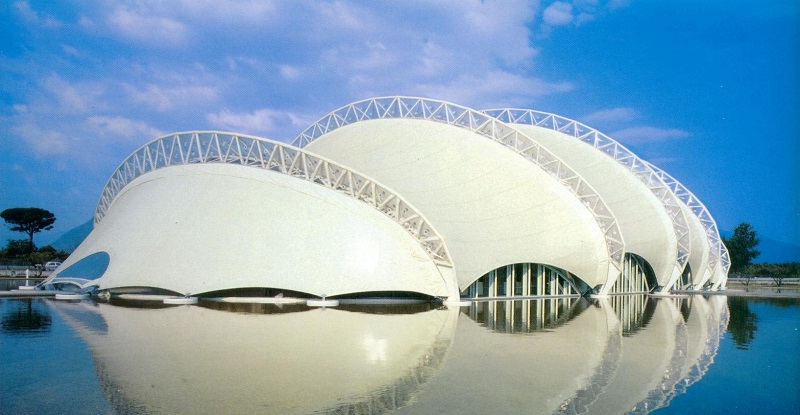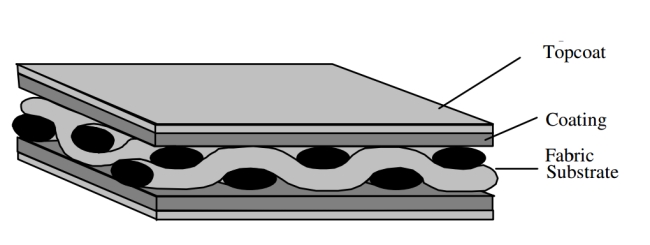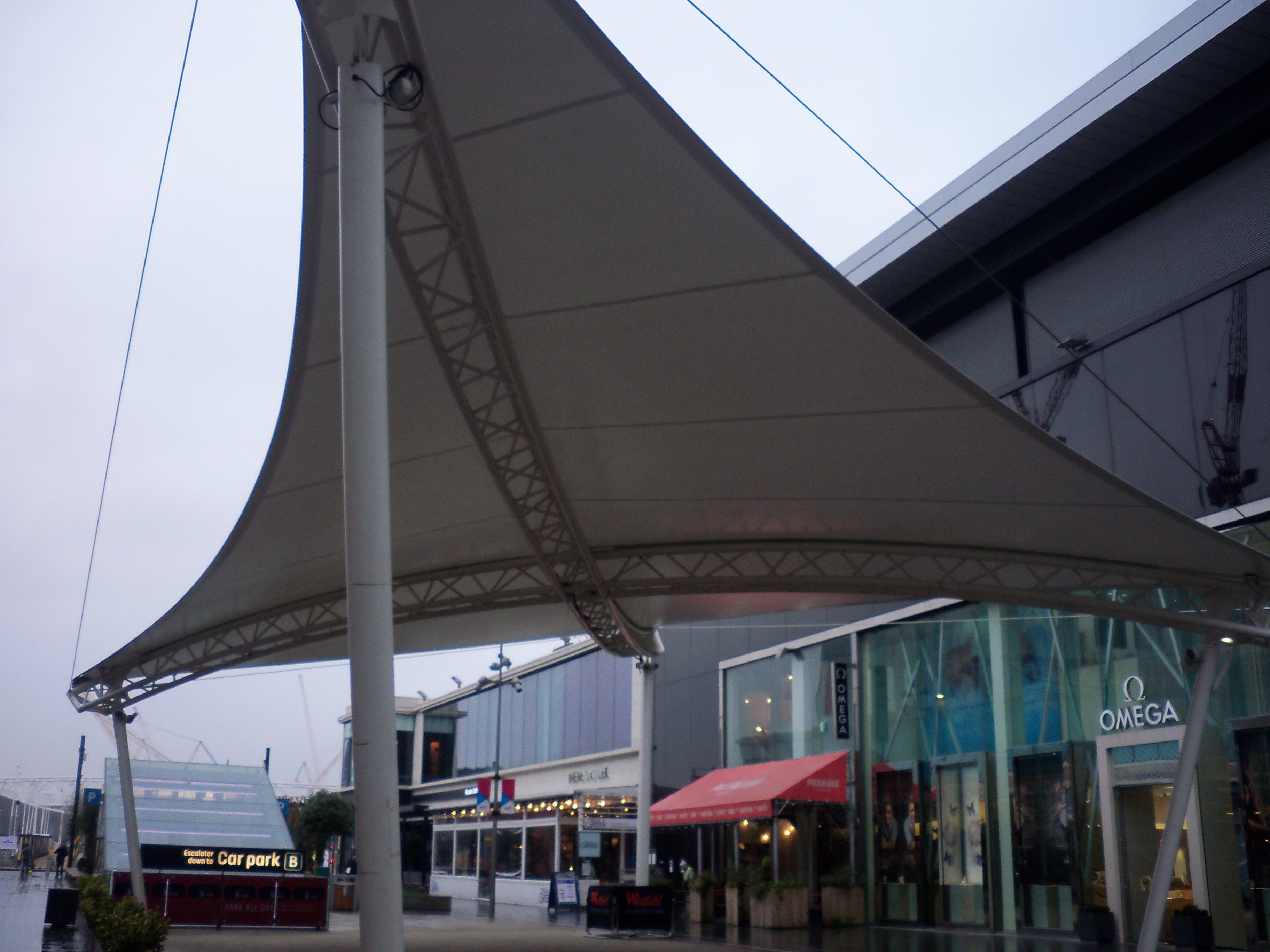Fabric structures
Contents |
[edit] Introduction
Fabric structures are tensile structures in which a membrane is 'stretched' to form a three-dimensional surface that can be used to create a roof, shading, or decorative component. Sometimes described as 'modern tents', fabric structures use very little material compared to other forms of construction, and are typically translucent, but they provide little thermal mass or insulation and can have a shorter lifespan than some other materials.
Typically, the membrane is formed by a structural fabric, consisting of a woven base cloth, coated on both sides, and held in position by tension forces imposed by a structural framework or a cabling system. Unlike conventional roofing systems, fabric structures can cover very large areas with no supporting columns. This makes them particularly suitable for buildings such as sports faculties, auditoriums, shopping centres, transport interchanges, and so on.
They can be relatively quick to construct and can be relocatable, making them suitable for temporary uses, and so have historically be associated with structures such as circus tents, or with military uses.
[edit] History
The origins of fabric structures can be traced back more than 44,000 years to the ice age and the Siberian Steppe, where remains have been found of simple shelters constructed from animal skins draped between sticks. Fabric structures developed and thrived predominately in regions where materials were scarce, or where survival required mobility; both conditions which tend to be brought about by low rainfall.
From these purely functional origins however, the tent evolved over many centuries to become a symbol of frivolity. Fabric structures became almost entirely recreational, and other than for military purposes were used in ways which ran entirely contrary to their functional origins.
This was to change during the nineteenth and twentieth centuries as architects became inspired by technological breakthroughs in structural engineering and architectural theorising on an emerging functional aesthetic.
The architect, Frei Otto, began exhaustive investigations into the structural principles behind a new generation of fabric buildings, and ultimately, this led to the extraordinary developments we now associate with modern fabric structures such as the roof of the Hajj Terminal at Jeddah Airport, the Millennium Dome and Denver International Airport.
[edit] Materials
The earliest fabrics were formed by simple membranes extracted from animals or vegetables. Later these membranes were cut into strips and interlaced to form larger, more practical textiles, and eventually these strips were twisted into circular sections allowing the manufacture of flexible, continuos fibres with enhanced strength.
Cotton was the first material to possess any significant structural strength but modern fabric structures tend to be formed using PVC coated polyester or PTFE coated glass.
Topcoats of protective fluorinated polymer lacquers (PVDF) applied to PVC coated polyester enhance its 'cleanability' and provide additional protection. In average climates, this fabric can last 15-20 years, or around 5 years less in sites where there is high exposure to sunlight.
PFTE-coated glass cloth is more expensive, but is strong and durable, and can have a lifespan of 30 to 50 years. It also has the advantage of being low maintenance and self-cleaning.
More recently, high performance materials such as silicone coated glass, woven PTFE fibre, ETFE foil, laminated open weave grids and insulated and phase change materials have been developed, however, PVC coated polyester and PTFE coated glass remain the industry standards.
These tensile fabrics, (sometimes referred to as structural membranes or architectural fabrics) are available in a wide range of thicknesses, strengths, colours and translucencies.
For more information see: The development of structural membranes and Architectural fabrics.
[edit] Properties and characteristics
Fabric structures are generally given their structural stability by double curvature. This may be:
- Anticlastic (saddle shaped), where the two axes of the fabric curve in opposite directions.
- Synclastic (dome shaped), where the two axis of the fabric curve in the same direction.
Anticlastic shapes tend to be formed by cables at the perimeter of fabric panels pulling them into tension, whilst synclastic shapes tend to be formed by internal air pressure (similar to blowing up a balloon, but at a very low pressure not noticeable to occupants).
Whilst the fabric itself may be very thin (perhaps just 1 mm), the tensile force imposed on it to ensure it remains stable under load can be high, and so the supporting structure required can be significant to transfer loads to the foundations.
The non-linear, dynamic behaviour of architectural fabrics can be modelled using specialist form-finding software. This allows designers to vary the elements, boundary conditions and geometry of the design and rapidly determine the most efficient structural solution. This software can also be used to generate cutting patterns for automatically cutting the fabric panels to create the form required. For more information see: The structural behaviour of architectural fabric structures.
[edit] Related articles on Designing Buildings Wiki
- Air-supported structure.
- Anticlastic.
- Architectural fabrics.
- Carbon fibre.
- Catenary.
- ETFE.
- Inflatable building.
- Nylon.
- Polypropylene.
- Polyvinyl chloride PVC.
- PTFE.
- Stadium.
- Stretched-skin ceiling.
- Structural membrane.
- Structural systems.
- Tensile structures.
- Thermal behaviour of architectural fabric structures.
- The history of fabric structures.
- The development of structural membranes.
- The thermal behaviour of spaces enclosed by fabric membranes.
- The structural behaviour of architectural fabric structures.
- Types of building.
- Types of roof.
Featured articles and news
RTPI leader to become new CIOB Chief Executive Officer
Dr Victoria Hills MRTPI, FICE to take over after Caroline Gumble’s departure.
Social and affordable housing, a long term plan for delivery
The “Delivering a Decade of Renewal for Social and Affordable Housing” strategy sets out future path.
A change to adoptive architecture
Effects of global weather warming on architectural detailing, material choice and human interaction.
The proposed publicly owned and backed subsidiary of Homes England, to facilitate new homes.
How big is the problem and what can we do to mitigate the effects?
Overheating guidance and tools for building designers
A number of cool guides to help with the heat.
The UK's Modern Industrial Strategy: A 10 year plan
Previous consultation criticism, current key elements and general support with some persisting reservations.
Building Safety Regulator reforms
New roles, new staff and a new fast track service pave the way for a single construction regulator.
Architectural Technologist CPDs and Communications
CIAT CPD… and how you can do it!
Cooling centres and cool spaces
Managing extreme heat in cities by directing the public to places for heat stress relief and water sources.
Winter gardens: A brief history and warm variations
Extending the season with glass in different forms and terms.
Restoring Great Yarmouth's Winter Gardens
Transforming one of the least sustainable constructions imaginable.
Construction Skills Mission Board launch sector drive
Newly formed government and industry collaboration set strategy for recruiting an additional 100,000 construction workers a year.
New Architects Code comes into effect in September 2025
ARB Architects Code of Conduct and Practice available with ongoing consultation regarding guidance.
Welsh Skills Body (Medr) launches ambitious plan
The new skills body brings together funding and regulation of tertiary education and research for the devolved nation.
Paul Gandy FCIOB announced as next CIOB President
Former Tilbury Douglas CEO takes helm.
UK Infrastructure: A 10 Year Strategy. In brief with reactions
With the National Infrastructure and Service Transformation Authority (NISTA).


























Comments
Not a very sustainable material!
Where is your evidence for that? They are very light weight, use very little material compared to any other construction material, require little supporting structure, are durable, self cleaning and allow natural lighting of spaces below.